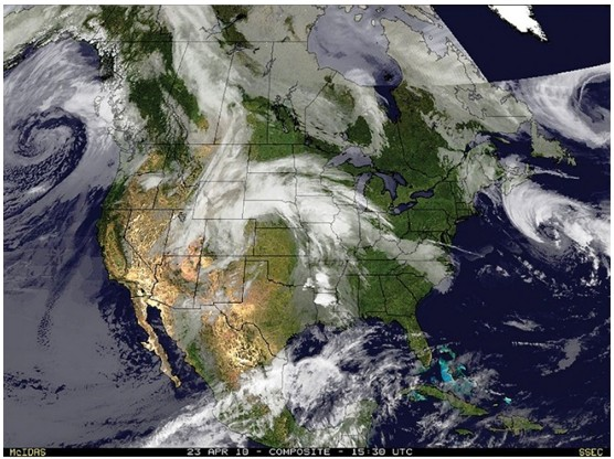This satellite image shows conditions on Day 1 of the weather investigation. What is likely to be the general path of the storm system in the center of the U.S. from this day to the next (Day 2)?

A) West to east, steered by the westerlies
B) West to east, steered by the trade winds and ITCZ
C) East to west, steered by the westerlies
D) East to west, steered by the trade winds and ITCZ
A) West to east, steered by the westerlies
You might also like to view...
Which of the following describes why a fluffy covering of snow is able to protect sensitive plants and their root systems from damaging low temperatures?
A. Snow is a good insulator. B. Melting snow releases latent heat. C. Snow is a good emitter of infrared energy. D. Snow is a good reflector of sunlight.
When organisms living in seawater grow shells, the ratio between the isotopes of oxygen (18O/16O) trapped in their shell is dependent on the sea temperature
Why might geologists collect these sea shells from deep-sea sediments that are Pleistocene in age and measure their oxygen isotope ratios? A) The organisms live near the surface, so their oxygen isotope ratios record surface temperature during Earth's great climate fluctuations of the ice age. B) They want to know how metabolism of the organism affects the oxygen isotope ratios. C) They might want to know how cold the water was at the seafloor in the past. D) The organisms live in the photic zone, and so photosynthesis must be the main factor in the oxygen content.
The Pacific Rim economy accounts for how much of the world's GDP?
A) 45% B) 58% C) 65% D) 73% E) none of the above
Regarding the federal Lead-Based Paint Hazard Reduction Act, which statement is TRUE?
a. all residential housing built before 1978 must be tested for the presence of lead-based paint before being listed for sale or rent b. a disclosure statement must be attached to all sales contracts and leases involving residential properties built before 1978. c. a lead-hazard pamphlet must be distributed to all prospective buyers but not to tenants d. purchases of housing built before 1978 must be given five days to test the property for the presence of lead-based paint